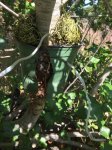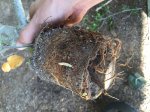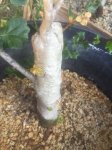JJshives
Sapling
So I started an air layer on a coast live oak in my yard about a year and a half ago and recently separated it. My only previous attempt at an air layer was with a ficus and apparently they are one of the easiest/fastest so thats not saying much. I didn't find much info about successful layers on this species, quercus agrifolia, prior to starting it, so I just went with a basic approach. I had difficulties with ants, consistent moisture, and then there was the amount of time it took to get roots. The first year was nothing but callous. I re-scraped the cambium in late January this year and then we finally had a couple good rain storms and all the local oak trees exploded with growth. We have been in a drought so I think this had something to do with the amount of new foliage produced and in turn the roots produced from the air layer. The pictures show root growth over a 2 month period.





Based on observations from this one, I wonder if I had started a fresh air layer in January when I re-scraped if it would have still produced roots or if the callous, which was substantial, was necessary for the root production? The trees of this species around me seem to grow intermittently all year but put on the most growth in spring.
Also, when I chose a spot to start the air layer I chose an area with decent taper and branching. A lot of the taper was lost as the tree grew, unfortunately. So, was this the result of the time required to successfully air layer this species? Or does this happen to a certain extent with any air layer?
The roots and medium were like concrete when I separated so I soaked the roots in a bucket with some Superthrive as I have with other successfully collected coast live oaks. After that, I removed the rest of the old trunk up to the callous as best I could and planted it in a shallow nursery pot. Hopefully it makes it, but so far so good.





Based on observations from this one, I wonder if I had started a fresh air layer in January when I re-scraped if it would have still produced roots or if the callous, which was substantial, was necessary for the root production? The trees of this species around me seem to grow intermittently all year but put on the most growth in spring.
Also, when I chose a spot to start the air layer I chose an area with decent taper and branching. A lot of the taper was lost as the tree grew, unfortunately. So, was this the result of the time required to successfully air layer this species? Or does this happen to a certain extent with any air layer?
The roots and medium were like concrete when I separated so I soaked the roots in a bucket with some Superthrive as I have with other successfully collected coast live oaks. After that, I removed the rest of the old trunk up to the callous as best I could and planted it in a shallow nursery pot. Hopefully it makes it, but so far so good.


